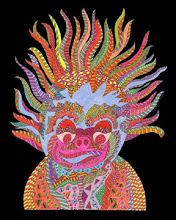
BIOTERRORISM >> VIRAL HEMORRHAGIC FEVER >> NEWS >>
Ebola strikes Congo again
Editor's note: This story was revised Dec 30 to make clear that as of Dec 29, only two cases in the outbreak had been confirmed as Ebola. During the DRC's 2007 outbreak the government confirmed 17 cases, down from 25 it reported earlier, and initial reports during that outbreak mentioned as many as 395 suspected Ebola cases. Some of the suspected patients had other diseases, including shigellosis.
Dec 29, 2008 (CIDRAP News) – The World Health Organization (WHO) recently reported an outbreak of Ebola hemorrhagic fever in the Democratic Republic of the Congo (DRC) that involves 34 suspected cases, with at least 9 deaths.
Based on reports from the DRC's health ministry, the WHO said in a Dec 26 statement that the outbreak was detected in Mweka district in Kasai Occidental (West Kasai) province and that a laboratory in Franceville, Gabon, confirmed the Ebola virus in samples from two of the patients. WHO spokesman Gregory Hartl told CIDRAP News that the two patients with confirmed infections are still alive.
The WHO said a lab in Kinshasa also confirmed Shigella (bacterial) infections, but the agency did not say how many.
A spokesman from the medical aid group Medicins sans Frontieres (MSF, or Doctors Without Borders) said that two more people have died of suspected Ebola infections, raising the number of deaths possibly caused by Ebola to 11, according to a report today from Agence France-Presse.
The DRC's last Ebola outbreak, in September 2007, also hit West Kasai province and also featured Shigella infections in some patients, according to previous reports. Seventeen cases and six deaths were reported in that outbreak.
From the number of suspected cases and deaths in the ongoing outbreak, the WHO said the case-fatality rate is 26%. The agency said that additional samples have been sent to the lab in Kinshasa. The statement did not say which Ebola subtype had sickened people in the outbreak.
The Ebola virus is highly contagious and causes a high fatality rate, ranging from about 50% to 90%. Initial symptoms include fever, headache, joint and muscle aches, sore throat, and weakness, followed by diarrhea, vomiting, and stomach pain, according to the US Centers for Disease Control and Prevention (CDC). Hallmarks of Ebola infection include internal and external bleeding, and there is no vaccine or specific treatment for the disease.
In late 2007, researchers investigating an Ebola outbreak in Uganda, the DRC's neighbor to the east, identified a new Ebola subtype: Bundibugyo. Initial findings suggested that the case-fatality rate for Ebola Bundibugyo was about 36%, lower than that of the Zaire (80% to 90%) or Sudan (50% to 55%) subtypes, according to previous reports.
WHO experts are assisting the DRC's health ministry with the outbreak investigation and response at ministry headquarters and in the field, the WHO said. The agency said it has sent additional staff and supplies to the area, and a team of national and international experts has been sent to help control the outbreak.
The WHO said it hasn't received any reports that suggest international spread of the disease, and it advised countries not to impose travel or trade restrictions on the DRC.
Meanwhile, MSF said in a Dec 25 report that suspected cases have been reported since Nov 27. The group said nine of its Ebola specialists from Kinshasa and Brussels are working in Western Kasai province. MSF said an isolation ward is being built in the village of Kampungu and that the group's doctors are treating suspected patients and identifying those who may have been in contact with people who had or have the virus.
In other developments, government officials in the Philippines recently asked the United Nations Food and Agriculture Organization (FAO), the World Organization for Animal Health (OIE), and the WHO to send experts to help investigate the detection of the Ebola Reston virus in pigs, according to a Dec 23 statement from the FAO.
In early December the FAO announced that researchers had discovered the Ebola virus for the first time in pigs while investigating outbreaks of porcine reproductive respiratory syndrome (PRRS) at several Philippine swine producers. The Reston subtype can sicken monkeys, but it does not appear to clinically infect humans.
See also:
Dec 25 WHO statement
http://www.who.int/csr/don/2008_12_26a/en/index.html
Sep 11, 2007, CIDRAP News story "Ebola outbreak confirmed in Congo"
Nov 20, 2007, CIDRAP News story "Congo says Ebola outbreak is contained"
Dec 25 MSF statement
http://www.doctorswithoutborders.org/news/article.cfm?id=3275
CDC background information about Ebola
Nov 21 CIDRAP News story "Researchers report new species of deadly Ebola virus"
Dec 23 FAO statement
| Center for Infectious Disease Research & Policy Academic Health Center -- University of Minnesota Copyright © 2008 Regents of the University of Minnesota |
 Staff Writer
Staff Writer